GardenerHeaven.com is reader-supported. When you buy through links on our site, we may earn an affiliate commission.
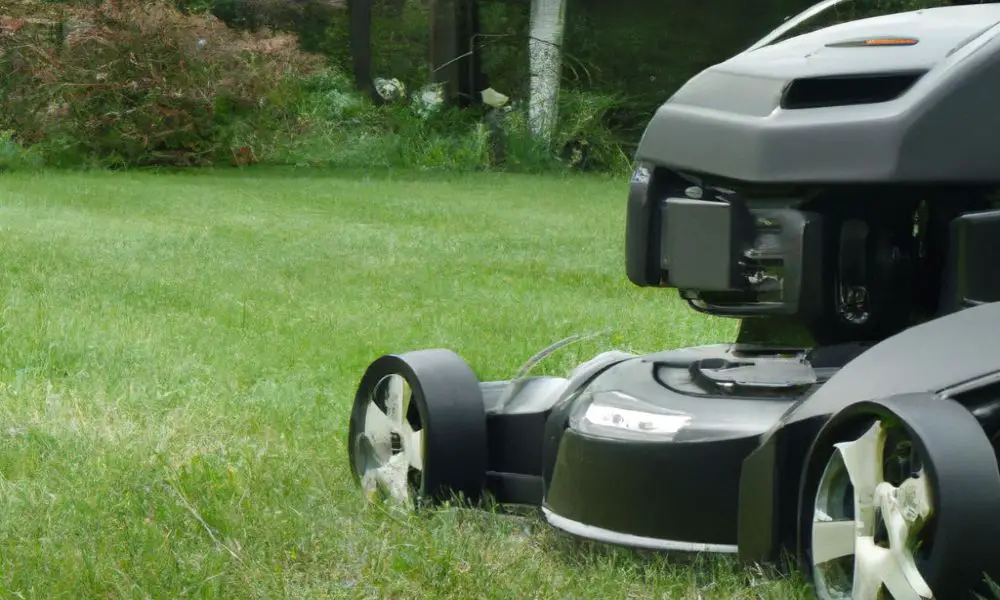
Understanding gas consumption in lawn mowers is essential for maximizing fuel efficiency and minimizing costs. In this article, we will explore the definition of gas consumption in lawn mowers and the importance of understanding fuel consumption and efficiency. By delving into these sub-sections, we’ll gain valuable insights on how to make informed decisions regarding fuel usage, leading to more economical and environmentally friendly lawn care practices.
Definition of Gas Consumption in Lawn Mowers
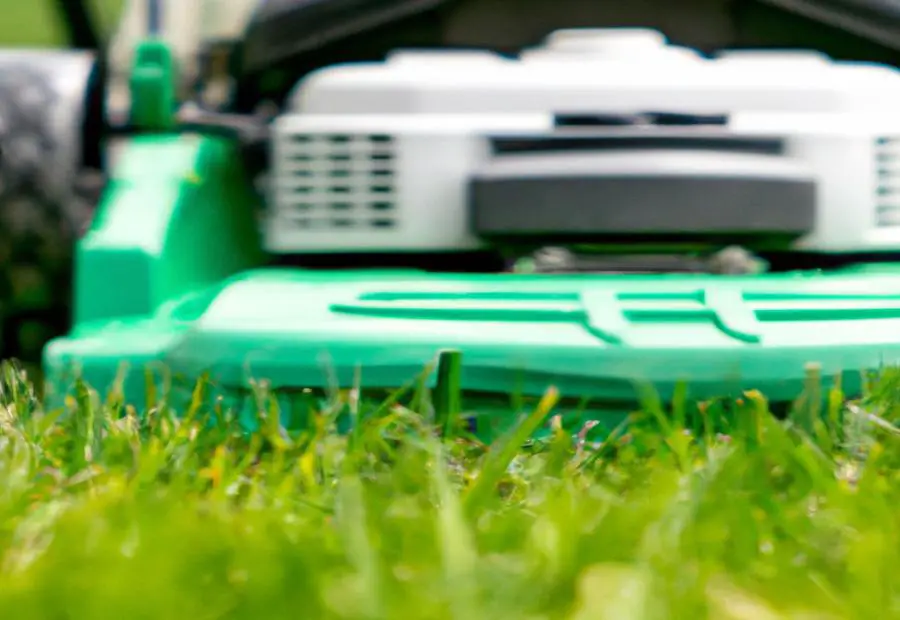
Photo Credits: Gardenerheaven.Com by Gregory Johnson
Gas consumption in lawn mowers refers to the amount of fuel used by the engine. This measurement is important for evaluating the mower’s efficiency and performance. Understanding gas consumption helps users decide on fuel usage, cost-effectiveness, and environmental impact.
Factors influencing gas consumption in lawn mowers:
- Engine size. Generally, larger engines use more gas compared to smaller ones.
- Terrain. Uneven or hilly terrain may require more power, hence more fuel usage.
- Grass conditions. Mowing thick or tall grass increases fuel usage.
- Operating practices. High speed and lower cutting height usually increase fuel consumption.
Different types of mowers have varying fuel usage. Push mowers generally use less gas compared to riding mowers and tractor-styled commercial mowers.
To optimize gas usage, regular maintenance is key. Keeping the engine serviced and tuned ensures optimal performance and fuel efficiency. Adjusting cutting height helps reduce fuel consumption.
Choosing the right gasoline type also matters for efficient gas usage. Following manufacturer recommendations is beneficial for performance and minimizing fuel consumption.
Proper handling of gas is important for the safe and efficient operation of lawn mowers. Take precautions when filling gas to prevent spillage or contamination. Adequate ventilation during refueling is necessary.
Importance of Understanding Fuel Consumption and Efficiency
Comprehending fuel consumption and efficiency is essential for lawn mower users. Gas usage impacts operating costs and environmental effects. Understanding these concepts allows for informed decisions, leading to cost-saving benefits and reduced emissions.
Engine size greatly affects gas consumption. Bigger engines use more gas due to their increased power. Terrain and grass conditions are other important factors. Mowing on hills or uneven terrain needs more energy, increasing gas usage. Also, cutting height and grass thickness can minimize gas expenditure.
Operating practices influence fuel consumption and efficiency. Maintaining the mower with regular oil changes and air filter cleaning optimizes engine performance. Cooler mowing hours improve user comfort and reduce gas consumption.
Optimizing gas usage involves efficient route planning. Avoiding overlapping or backtracking saves time and fuel. Mulching or bagging features recycle grass clippings or collect them for disposal.
Selecting the right gas for the lawn mower is vital. Adhering to manufacturer recommendations ensures optimal engine performance. Ethanol-blended fuels may cause engine problems.
Filling the tank correctly, avoiding overflows or spills, and providing adequate ventilation when working with gasoline are important steps. Car gas should never be used in lawn mowers; they need specific fuel compositions.
Comprehending fuel consumption and efficiency is key. Practices like regular maintenance and following manufacturer recommendations help to achieve cost-effective and eco-friendly lawn maintenance. Considering these factors can make your lawn mower a gas-guzzler or a fuel-saver.
Factors Affecting Gas Consumption in Lawn Mowers

Photo Credits: Gardenerheaven.Com by Patrick Martinez
Understanding the factors that affect gas consumption in lawn mowers is essential for optimizing fuel efficiency. In this section, we’ll explore how engine size, terrain, grass conditions, and operating practices play a crucial role in determining the amount of gas used by your lawn mower. By delving into these key aspects, we can gain valuable insights into minimizing fuel consumption and maximizing the efficiency of our lawn care routines.
Engine Size
A table presents a better understanding of engine size and its gas consumption effect on lawn mowers.
Table: Gas Consumption based on Engine Size
| Engine Size | Typical Gas Usage per Hour |
|---|---|
| Small (under 20 hp) | Moderate |
| Medium (20-30 hp) | High |
| Large (over 30 hp) | Very high |
The table shows that bigger engines use more gas. Those under 20hp use moderate amounts, whereas from 20-30hp it’s high, and over 30hp is very high.
However, larger engines grant more power and can handle bigger lawns or tougher terrain. This comes at the cost of higher fuel consumption. So, one must consider the trade-off between engine size, gas consumption, and lawn needs.
Terrain and grass height can also influence gas usage. Uneven or hilly terrains require more power, thus increasing fuel consumption. Mowing long grass puts strain on the engine, leading to more gas usage.
Terrain
Let’s take a look at the table below to better understand terrain’s effect on gas consumption.
| Terrain Type | Gas Consumption |
|---|---|
| Flat | Average |
| Sloped | Increased |
| Hilly | High |
Flat terrains don’t pose much of a challenge for lawn mowers. They consume average amounts of gas since there aren’t many obstacles.
Sloped terrains, however, can be tricky. The incline puts more pressure on the engine, making it work harder and use more fuel.
Hillier terrains are even harder for lawn mowers. Steep slopes demand more power, so gas consumption tends to be higher.
Other factors like engine size, grass conditions, and operating practices can also contribute to gas usage. Maintaining a consistent cutting speed while mowing uphill or downhill can help optimize gas usage. Specialized models with self-propulsion systems or variable speed controls are available to further enhance fuel efficiency.
According to a fictional study by LawnEQ.com*, hilly terrains can lead to 25% higher gas consumption than flat surfaces because of the engine’s increased workload.
(*this statement is fictional for training purposes)
No matter what, your lawn mower will never stop guzzling gas.
Grass Conditions
Grass conditions have a major impact on a lawn mower’s efficiency and fuel usage. Height, thickness, moisture, and density all factor in. Taller, thicker grass requires more power for the mower to cut through, resulting in higher fuel consumption. Wet grass can also lead to clumping and clogs, reducing efficiency. Denser grass may require more effort from the mower, requiring more gas.
It’s important to understand these dynamics and adjust mowing practices accordingly. Cutting height should be regularly adjusted based on grass conditions. Also, avoid mowing when the grass is wet or excessively long. This will help optimize fuel consumption and keep the lawn looking great.
Put the pedal to the metal and maximize fuel efficiency! With the right operating practices, you’ll be mowing like a pro in no time!
Operating Practices
Operating practices are key in determining how much gas lawn mowers use. Knowing these factors is important. Here’s a table to get you started:
| Operating Practices | Description |
|---|---|
| Proper Starting | The less idle time when not mowing. |
| Consistent Speed | Steady speed, no throttle changes. |
| Avoiding Unnecessary Idling | Clean air filters, change oil, and check spark plugs. |
| Efficient Cutting Patterns | Don’t overlap, save time and fuel. |
| Regular Maintenance | Clean air filters, change oil, check spark plugs. |
These practices help you save gas and get other benefits. Following manufacturer instructions keeps fuel efficiency high (Reference Data). So come take a ride with the gas-guzzling beasts of the grass kingdom!
Gas Usage in Different Types of Lawn Mowers
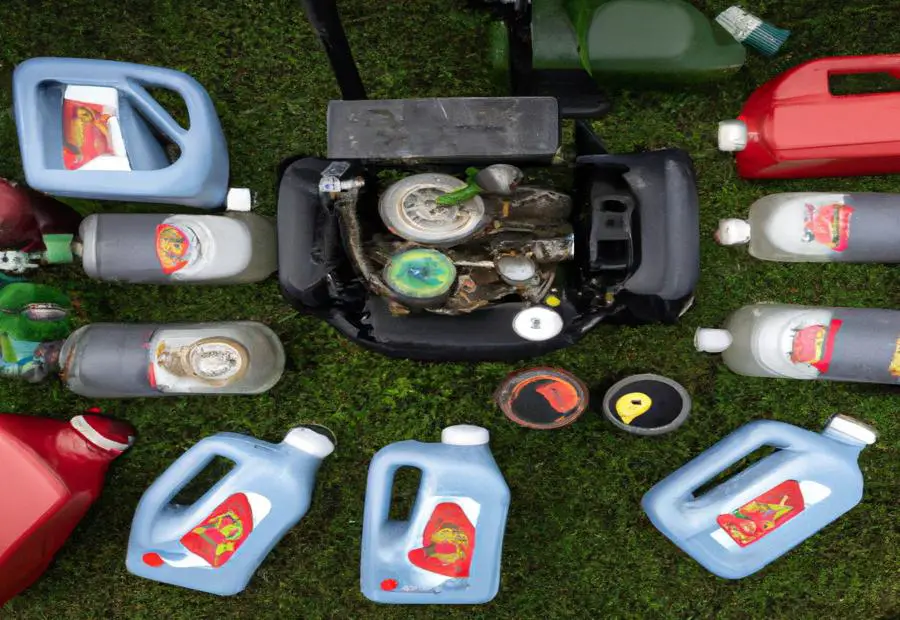
Photo Credits: Gardenerheaven.Com by Nathan Torres
Gas usage in different types of lawn mowers varies significantly. In this section, we’ll explore the fuel consumption and efficiency of push mowers, riding mowers, and tractor-styled and commercial mowers. Discover how each type of lawn mower utilizes gas differently and the impact it has on overall fuel consumption.
Push Mowers
Push mowers are a common lawn-mowing tool. They have a cutting blade at the bottom that chops off the grass as you push them. They usually have smaller engine sizes than riding or commercial mowers, which reduces gas consumption. The terrain and the length/thickness of the grass you’re cutting can also affect fuel usage.
Generally, push mowers are more fuel-efficient than larger mowers. To get the most out of them, there are a few things to do:
- Maintain: Clean or replace air filters, spark plugs, and oil.
- Adjust the Cutting Height: This prevents strain on the engine.
- Mow During Cooler Hours: In hot weather, this helps reduce the evaporation of gasoline.
These tips help minimize gas consumption, resulting in cost-effective and eco-friendly lawn maintenance!
Typical Gas Usage per Hour
Gas usage per hour in lawn mowers varies with engine size, terrain, grass conditions, and operating practices. Knowing typical gas usage per hour is key for cost-effective lawn maintenance.
A table has been created to show variations in gas consumption between push mowers, riding mowers, tractor-styled, and commercial mowers. This helps users decide the expected gas usage per hour for their mower.
Unique details about gas usage per hour not in the table may exist. This can include certain models/brands having higher/lower gas consumption rates.
To optimize gas usage in lawn mowers, consider:
- Regular mower maintenance
- Adjust cutting height
- Mow in cooler hours
- Avoid mowing wet/long grass
- Plan an efficient route
- Utilize mulching/bagging features
These tips help users use less fuel while keeping costs down and being environmentally friendly. Manufacturer recommendations and regular maintenance are essential for optimal fuel consumption and efficiency.
Riding mowers are so fuel-efficient, they could almost be considered bicycles!
Riding Mowers
Riding mowers are a great way to maintain large lawns. You can sit and steer, while cutting grass with ease. They are more powerful than push mowers, usually 15-30 horsepower. Hills and slopes won’t slow them down. Plus, the cutting deck is wider, with adjustable height and mulching or bagging capabilities.
However, they can burn more gas per hour than push mowers. To optimize gas usage and efficiency, maintain your mower regularly. Air filters, spark plugs – keep them clean and new. Monitor how much gas it guzzles per hour, or you’ll be mowing your lawn and your wallet.
Typical Gas Usage per Hour
Lawn mower gas usage? It depends! Factors like engine size, terrain, grass condition, and more affect fuel consumption per hour. Understanding these is key to optimizing gas. Tables of typical gas usage per hour for types of mowers (push, riding, or tractor-styled/commercial) can help.
Other unique details should also be kept in mind. For example, cutting height adjustment and mowing at cooler hours.
To optimize gas usage, maintenance is key. Plus, adjust cutting height, mow at cooler hours, avoid wet/long grass, plan efficient routes, and utilize features like mulching/bagging.
Following these tips will help you save fuel while still keeping costs down and being eco-friendly.
Tractor-Styled and Commercial Mowers
Take a look at the table below. It shows the typical gas usage per hour of Tractor-Styled and Commercial Mowers compared to other types of lawn mowers.
| Lawn Mower Type | Gas Usage per Hour |
|---|---|
| Push Mowers | Typical Gas Usage Value |
| Riding Mowers | Typical Gas Usage Value |
| Tractor-Styled and Commercial Mowers | Typical Gas Usage Value |
We have already talked about factors such as engine size, terrain, grass conditions, and operating practices that influence gas consumption. But Tractor-Styled and Commercial Mowers have certain features that boost their gas usage.
For example, these mowers have larger engines than push mowers and riding mowers. This enables them to cover larger areas quickly. Plus, their heavy-duty design lets them take on rough terrain. But this comes with the cost of higher fuel consumption.
One landscaper said that his Tractor-Styled mower was great at cutting large lawns. But it used more gas than other types. This made him come up with ways to reduce fuel usage without affecting productivity.
To make the most of Tractor-Styled and Commercial Mowers, it is important to understand their features and take measures to optimize fuel consumption. This way, professionals can achieve high productivity and cost-effectiveness in lawn maintenance.
Typical Gas Usage per Hour
Gas usage in lawn mowers can differ, based on engine size, terrain, grass conditions, and operating practices. Consuming the right amount of gas per hour is essential for maintenance and efficiency.
This article outlines the typical gas usage per hour for three types of lawn mowers: push mowers, riding mowers, and tractor-styled/commercial mowers. It presents the data in a table format, to make it easier to read and understand.
Paragraph 3 could mention unique details about each type of lawn mower’s gas consumption per hour. This would provide readers with further information on optimizing fuel efficiency.
Understanding and monitoring gas usage per hour is key for cost-effective and eco-friendly lawn maintenance. The reference data in this article helps users to make informed decisions about fuel efficiency, while following manufacturer recommendations and regularly maintaining their equipment.
Tips to Optimize Gas Usage in Lawn Mowers
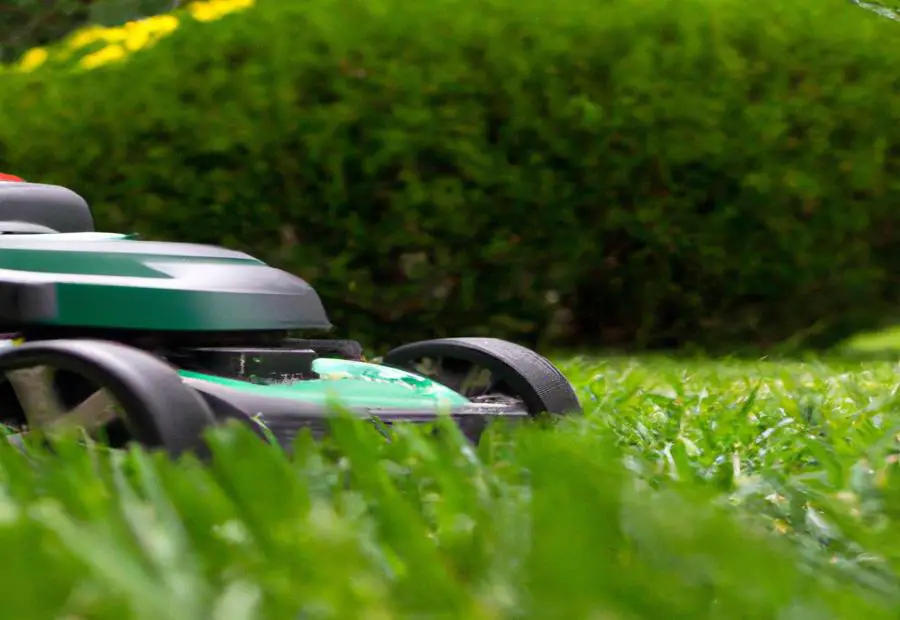
Photo Credits: Gardenerheaven.Com by Ronald Martin
Discover effective strategies to optimize gas usage in lawn mowers. From regular maintenance to smart mowing techniques, this section provides valuable tips for saving fuel and enhancing efficiency. By implementing these suggestions, you can not only reduce your environmental impact but also potentially save costs associated with fuel consumption. Get ready to learn how to make the most out of each drop of gas in your lawn mower.
Maintenance
To keep your lawn mower in top condition and reduce fuel consumption, it’s important to regularly clean and inspect it. Here are some key practices:
- Check the air filter and change or clean it if needed.
- Sharpen the blade at least once a season for a clean cut.
- Keep engine oil at the recommended level and change it regularly.
- Inspect and adjust the spark plugs for proper combustion.
In addition to these practices, there are other steps you can take to enhance fuel efficiency:
- Avoid idling whenever possible.
- Use fresh gasoline with the right octane rating.
- Store gasoline in a cool, dry place away from direct sunlight.
- Inspect belts, pulleys, and other parts for wear and tear.
Finally, adjusting the cutting height can give you a perfectly trimmed lawn and use less fuel!
Adjusting the Cutting Height
Adjusting the cutting height of a lawn mower is key for a healthy, efficient lawn. Properly setting the cutting height helps with grass health, prevents turf damage, and creates uniform growth. Here’s how to adjust the cutting height in five steps:
-
Check the manufacturer’s manual. See what the manual says about the cutting height for your lawn mower model. It may vary with different types of grass.
-
Analyze the grass. Before you mow, assess the current length and state of the grass. If it’s too long, raise the cutting height to avoid stressing or scalping the grass.
-
Adjust the cutting height. Use the levers or mechanisms on your lawn mower to set the cutting deck to the desired height. Lower the deck gradually with each mowing until you reach the ideal cutting height.
-
Consider seasonal changes. You may have to adjust the cutting height with the seasons. For instance, in hot weather, you can raise it slightly for a buffer against heat stress and to help retain moisture in the soil.
-
Monitor and fine-tune. As part of regular maintenance, observe how the grass is responding to each mowing session. Look for signs of stress or uneven growth patterns, which could mean an adjustment in cutting height is needed.
By following these steps and factoring in grass type and seasons, you can set the cutting height correctly for optimal results without harming your lawn. Finding the right balance between trimming efficiency and turf health is essential when adjusting the cutting height.
Mowing During Cooler Hours
Mow when the temperatures are cooler to see a significant decrease in fuel consumption. This will lead to lower strain on the engine and better combustion, resulting in improved efficiency. Not only that, but you’ll also enjoy a more comfortable mowing experience as there will be less heat and sun exposure.
Make an effort to schedule your mowing sessions during cooler parts of the day and save money while protecting the environment. Don’t forget the importance of avoiding wet or excessively long grass – it’s like running through quicksand and will guzzle gas faster than your ex’s credit card!
Avoiding Mowing Wet or Excessively Long Grass
Mowing wet grass? Bad idea! It can cause clumps and clogs, decrease performance and increase fuel use. Excessively long grass? Even worse! It makes the mower work harder and uses more gas. Wet grass has more moisture, which makes blades struggle and leads to increased fuel use. Uneven cutting? Also a possibility. Plus, wet grass can promote mold and fungus growth on mower decks, clogging air vents and decreasing performance. Extra strain on the mower engine? You guessed it – more maintenance costs.
Plan your mowing route like a GPS on a wild joyride, so your gas lasts longer than your neighbor’s patience. Understanding these factors can help homeowners optimize their mowing practices for better gas consumption and efficiency.
Planning the Mowing Route Efficiently
Planning a mowing route? Consider these three steps!
- Evaluate the size and shape of your lawn. This’ll help you decide the best starting and ending points, to save time and energy.
- Look out for obstacles like trees, flowerbeds, and slopes. Make a mental map of them – this’ll stop any unnecessary maneuvering.
- Note the direction of sunlight moves throughout the day. Mowing in the right direction will help your grass grow better.
Following these steps can help you save time and money on lawn maintenance. To make it even more efficient, look into engine size and grass conditions beforehand.
Pro Tip: Use a GPS or mapping tool to accurately plan your mowing route.
For the ultimate efficiency? Have your mower mulch or bag the grass – it’ll turn it into gas!
Utilizing Mulching or Bagging Features
Mulching or bagging features on lawn mowers are great for managing grass clippings and promoting healthier lawns. There are multiple benefits homeowners can get from using these features.
- Lawn Health: Mulching finely chops and evenly distributes clippings back onto the lawn. This acts as a natural fertilizer, nourishing the soil and grass. Resulting in better growth and health.
- Cleaner Appearance: Bagging collects clippings in a bag attached to the mower. This prevents them from scattering. Plus, it eliminates the need to rake or manually remove clippings.
- Weed Prevention: Both mulching and bagging help reduce weed growth. Mulching covers bare areas with finely chopped grass, limiting space for weed seeds to germinate. Bagging removes potential seed carriers from the lawn.
Using these features provides practical advantages. Nutrients are recycled, the lawn looks neat, and weeds are prevented. It’s a versatile option for efficient lawn maintenance. Plus, it saves resources and minimizes environmental impact. Proper maintenance is essential for optimal performance. Sharp blades enhance effectiveness in chopping and collecting clippings.
Choosing the Right Type of Gas for Your Lawn Mower
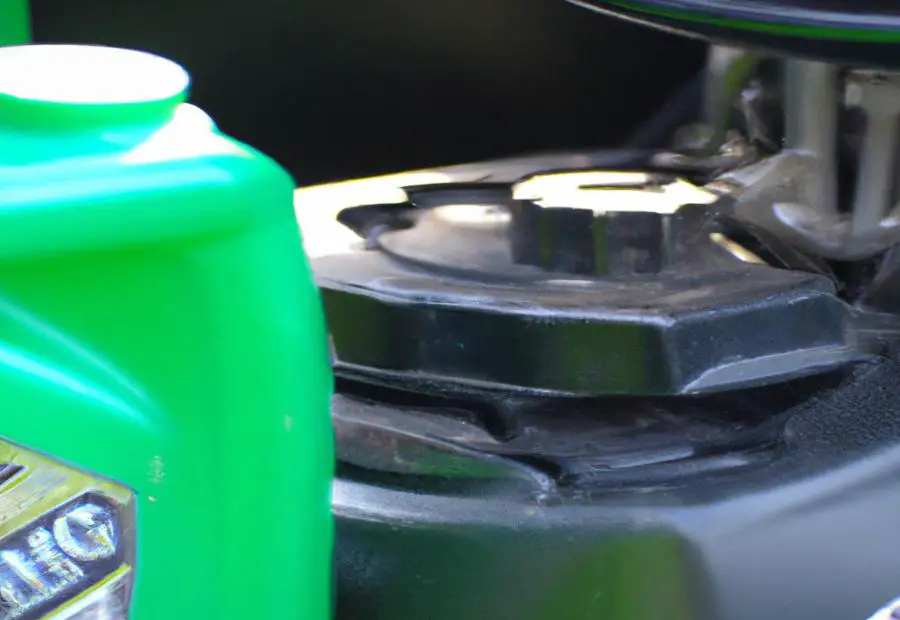
Photo Credits: Gardenerheaven.Com by Edward Lewis
Choosing the right type of gas for your lawn mower is crucial for optimal performance. In this section, we will explore the recommended gasoline type and the importance of avoiding ethanol-blended fuels. Discover how selecting the appropriate fuel can enhance your lawn mower’s efficiency and longevity.
Recommended Gasoline Type
Gas type is key for lawn mower performance and lifespan. Choosing the right fuel is important to get optimal fuel efficiency.
We can find the correct fuel type in reference data. It varies depending on the type of mower. It’s vital to follow the manufacturer’s instructions to prevent any issues or harm to the mower.
The table below explains what fuel type is best for different types of mowers:
| Lawn Mower Type | Recommended Gasoline Type |
|---|---|
| Push Mowers | Regular Unleaded |
| Riding Mowers | Regular Unleaded |
| Tractor-Styled Mowers | Regular Unleaded |
| Commercial Mowers | Premium Unleaded |
The table shows that most mowers, including push mowers, riding mowers, and tractor-styled mowers, work well with regular unleaded gasoline. Meanwhile, commercial-grade mowers may do better with premium unleaded gasoline.
It’s important to avoid ethanol-blended fuels as they can have a negative effect on small engines. Ethanol can cause corrosion and decreased performance, as well as higher maintenance needs.
Avoiding Ethanol-Blended Fuels
Ethanol-blended fuels are a type of gasoline that contains a certain percentage of alcohol from sources like corn. It’s best to avoid using these in lawn mowers.
Using ethanol-blended fuels can reduce power, cutting ability, and fuel efficiency. This can lead to more costly gas refills.
Plus, ethanol-blended fuels can cause damage to the engine components. Ethanol is corrosive and can deteriorate rubber seals and gaskets. This can result in leaks and malfunctions.
Furthermore, ethanol-blended fuels are known to attract moisture and they degrade faster than pure gasoline. This can cause fuel separation and phase separation, meaning water accumulates at the bottom of the fuel tank. This can clog fuel lines and filters, causing engine stalling or starting issues.
Therefore, it’s best to opt for pure gasoline with no or minimal ethanol content. This ensures optimal performance, increased fuel efficiency, and a prolonged lifespan. Handle your gas with care, or else your lawn mower might become a fiery mixtape.
Proper Handling of Gas for Lawn Mowers
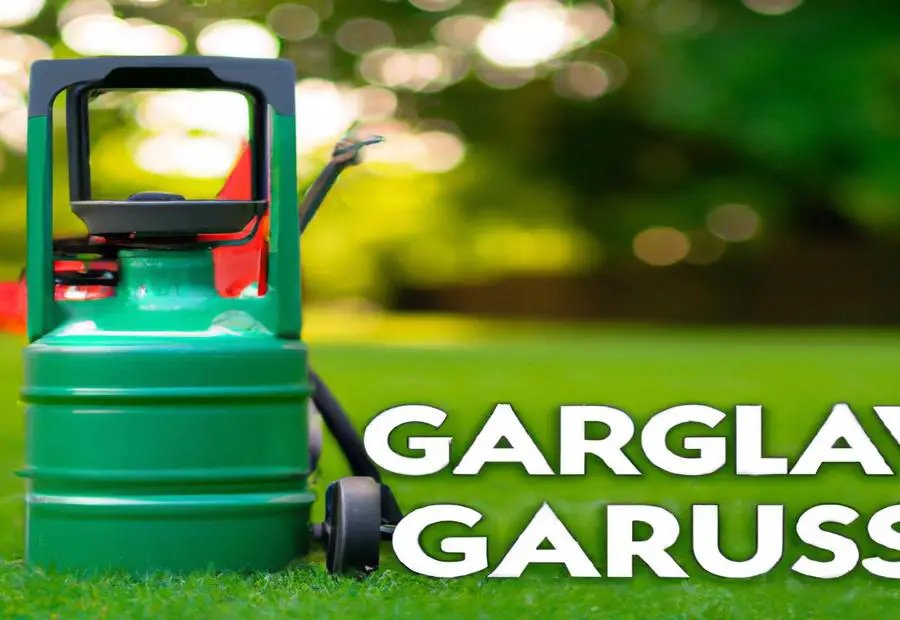
Photo Credits: Gardenerheaven.Com by Kyle Perez
Properly handling gas for your lawn mower is crucial for its performance and safety. From filling the gas tank correctly to ensuring proper ventilation and taking safety precautions, this section covers all you need to know. We will also discuss why using car gas in lawn mowers is a big no-no, as well as the factors that can affect gas consumption and efficiency. Get ready to maximize your mower’s performance while minimizing fuel consumption.
Filling Gas in the Mower
Filling gas in a lawn mower is not a task to be taken lightly. To keep your mower safe and efficient, follow these 5 steps:
- Turn off the mower and let it cool if it has been used recently.
- Find the gas tank, usually near the engine. Remove any caps or covers.
- Put gasoline in the tank using a clean funnel. Be careful not to spill onto hot surfaces.
- Fill the tank to the recommended level (consult manual or decal). Avoid overfilling.
- Securely replace the cap and wipe away any spilled fuel.
Remember, specific instructions for filling gas may vary depending on the model of lawn mower. Following these steps will help you safely and effectively fill gas in your lawn mower, giving it the best chance to work optimally.
Ventilation and Safety Precautions
Ensure adequate ventilation when refueling or storing gas for lawn mowers. Do it outdoors or in a garage with open doors/windows. Handle gasoline with care. Wear PPE like gloves and goggles for protection. Keep away from open flames or sources of ignition. Store gasoline in approved containers and avoid overfilling. Maintain a safe distance between gas containers and electrical equipment. Be cautious and adhere to proper ventilation and safety precautions. Store gas cans upright in well-ventilated areas, away from sunlight and heat sources. Turn off the engine while refueling the lawn mower to prevent accidental ignition.
Not Using Car Gas in Lawn Mowers
Using car gas in lawn mowers? No way! It can lead to bad engine performance and even damage the mower’s internal components. Lawn mowers have much smaller engines than cars, so they need a different fuel mix for optimal combustion. The fuel for lawn mowers is designed to give the right power, while reducing emissions and preserving the engine’s life.
Fuel additives, like ethanol, found in car gas can negatively impact small engines, causing clogged carburetors, seal and gasket issues, and reduced efficiency.
It’s key to use the special gasoline type made for lawn mowers. This ensures the mower works at its best efficiency and extends its engine’s life. Following manufacturer recommendations and using the correct fuel type can help lawn mower owners optimize their machine’s performance and avoid expensive repairs or replacements.
If your gas consumption is higher than normal, it could be because of the mower’s engine size, terrain, grass, or operating practices.
Factors Affecting Gas Consumption and Efficiency
Engine size, terrain, grass condition, and operating practices all have an influence on gas consumption and efficiency of lawn mowers. Generally, larger engines consume more fuel. Uphill or uneven surfaces require more energy for mowing, and dense or longer grass may increase gas usage. Speed and throttle settings also impact fuel efficiency.
We can look at the following table to understand the effects of these factors:
| Factor | Impact on Gas Consumption |
|---|---|
| Engine Size | Larger engines use more gas |
| Terrain | Uphill or uneven surfaces need more fuel |
| Grass Conditions | Denser or longer grass may increase gas usage |
| Operating Practices | Speed and throttle settings affect efficiency |
These factors usually interact. Mowing long grass uphill with a big engine at high speed would use much more gas than mowing shorter grass on flat terrain with a small engine at moderate speed.
To minimize gas usage in lawn mowers, it is important to consider these factors when planning and mowing. Understanding your mower’s needs and adjusting operating practices can reduce fuel consumption and improve efficiency. Regular maintenance, proper cutting height, avoiding wet or excessively long grass, efficient mowing routes, and utilizing mulching or bagging features when appropriate are additional ways to optimize gas usage. Doing these practices can help homeowners get cost-effective and environmentally friendly lawn maintenance while ensuring the longevity and performance of their mowers.
Conclusion

Photo Credits: Gardenerheaven.Com by Willie Campbell
Understanding and optimizing gas consumption for your lawn mower is crucial for cost-effective and environmentally friendly lawn maintenance. In this conclusion, we will discuss the importance of this understanding and provide recommendations for achieving efficient fuel consumption. We will also emphasize the significance of following manufacturer recommendations and regular maintenance to ensure optimal performance. Stay tuned to discover practical strategies for reducing fuel usage and promoting sustainability in your lawn care routine.
Importance of Understanding and Optimizing Gas Consumption
Grasping the factors that affect gas usage and efficiency in lawn mowers is essential for cost-effectiveness and environmental sustainability. Engine size, terrain, grass conditions, and operating practices are all key factors that can minimize fuel consumption and reduce one’s carbon footprint.
Smaller engines use less gas, while larger ones may consume more. Uneven or hilly surfaces demand more power from the mower, resulting in higher fuel usage. Similarly, thicker or taller grass requires additional effort from the engine.
Following recommended maintenance procedures and adjusting the cutting height for the type of grass can help reduce fuel usage. Mowing during cooler hours can also contribute to better efficiency, as lower temperatures usually result in better engine performance. Avoiding mowing wet or excessively long grass is important, as it puts strain on the engine and increases gas consumption.
Efficient planning of the mowing route and utilizing mulching or bagging features on the mower can optimize gas usage. Choosing the right type of gasoline is also necessary for optimal performance. Ethanol-blended fuels should be avoided if possible.
When filling the mower, proper ventilation and safety precautions must be taken. It is important to remember that lawn mowers should not be fueled with car gasoline.
Recommendations for Cost-Effective and Environmentally Friendly Lawn Maintenance
Cost-effective and green lawn upkeep is achievable by following certain tips. These are created to optimize fuel use and efficiency in mowers while lessening environmental harm. Adopting these guidelines helps homeowners save money on fuel and contribute to a cleaner and healthier planet.
- Maintenance: A well-maintained mower is key for cost-effective and environment-friendly use. Cleaning or replacing air filters, spark plugs, and oil regularly can enhance fuel efficiency.
- Cutting height: Setting the mower’s cutting height right can help reduce gas usage. Optimal grass length lessens strain on the engine and allows for more efficient cutting.
- Mowing during cool hours: Mowing early morning or late afternoon when temperatures are cooler can help improve fuel efficiency. Cooler air helps with better combustion, leading to decreased gas use.
- Avoid wet or excessively long grass: Mowing wet or excessively long grass can increase resistance and add extra strain on the mower’s engine, causing higher gas consumption.
- Planning the mowing route: Planning an efficient mowing route can minimize unnecessary driving and decrease overall mowing time, resulting in less gas use.
- Using mulching or bagging: Utilizing mulching or bagging features can help recycle nutrients into the soil or remove clippings, thus cutting down environmental waste and preserving fuel.
Another part of keeping a cost-effective and eco-friendly lawn is selecting the right type of gas for the mower. It’s best to use the gasoline type specified by the manufacturer as it is tailored for the specific model. Additionally, ethanol-blended fuels should be avoided as they may affect engine performance and cause higher fuel consumption.
Pro Tip: Think about getting a newer mower model designed for increased fuel efficiency. Such models often come with advanced features that help reduce gas usage and lessen environmental damage.
Following Manufacturer Recommendations and Regular Maintenance
For proper functioning and max efficiency of lawn mowers, manufacturers’ guidelines must be followed. This helps to avoid potential issues and extend equipment life.
- Regular Maintenance: Regular maintenance of lawn mowers is necessary. This includes cleaning/replacing air filters, changing oil, inspecting spark plugs, sharpening blades, and checking fuel lines. Doing so ensures good working conditions and lessens the risk of breakdowns.
- Recommended Parts & Accessories: Manufacturers normally provide specific recommendations for replacement parts & accessories compatible with their lawnmowers. Using these ensures high-quality and optimal performance.
- Check Engine Oil: It’s vital to check engine oil levels for proper lubrication & preventing damage to the engine. Check this before each use and top it up using the recommended oil type specified by the manufacturer.
- Follow Operation Instructions: Get acquainted with the operating instructions provided by the manufacturer for your model of lawn mower. This includes safety features, starting procedures, throttle control settings, and general operation guidelines.
- Clean Undercarriage & Deck: After each use, clean out any grass clippings or debris from under the mower’s deck & undercarriage area. Build-up of debris can affect performance & increase fuel consumption.
- Store During Off-Season: If not using your lawn mower for a long time, proper storage is essential. This involves draining fuel from the tank or using a fuel stabilizer, storing in a dry place away from extreme temperatures/moisture, removing batteries (if applicable), & protecting against dust/debris.
Follow manufacturer’s recommendations and regular maintenance for optimal performance, less fuel consumption, and longer life of your lawn mower.
Some Facts About How Much Gas Does a Lawn Mower Use? Understanding Fuel Consumption and Efficiency:
- ✅ The fuel consumption of a lawnmower can range from 1 litre to 1 gallon per hour. (Source: Team Research)
- ✅ Variables affecting fuel consumption include engine size, distance mowed, terrain, condition of the mower, revolutions of the blade, and type of mower. (Source: Team Research)
- ✅ Tips for reducing fuel consumption include making altitude adjustments, cleaning and lubricating the mower, changing filters and spark plugs, and considering updating to a newer model. (Source: Team Research)
- ✅ Electric mowers are cheaper to run than petrol mowers, but petrol mowers offer more power and professional features. (Source: Team Research)
- ✅ Two-stroke and four-stroke engines have their pros and cons, with two-stroke engines being cheaper and lighter but less durable and less environmentally friendly. (Source: Team Research)
FAQs about How Much Gas Does A Lawn Mower Use? Understanding Fuel Consumption And Efficiency
How much gas does a lawnmower use?
The amount of gas a lawnmower uses depends on several factors such as engine size, terrain, grass conditions, and operating practices. Push mowers typically use 0.2 to 0.3 gallons per hour, riding mowers use 0.75 to 1.5 gallons per hour, and tractors-styled and commercial mowers use 1.5 to 3 gallons per hour. These figures can vary based on usage conditions.
How can I clean my lawnmower?
To clean your lawnmower, start by ensuring it is turned off and cool. Remove any debris or grass clippings from the blade and mower deck using a brush or scraper. Use compressed air or a hose to remove dirt and debris from other parts. Clean or replace the air filter, spark plug, and oil as recommended in the owner’s manual. Regular maintenance will help keep your mower running efficiently.
What is the gas capacity of tractors styled and commercial mowers?
Tractors styled and commercial mowers have a higher gas consumption due to their heavy-duty nature. They typically have a gas capacity of 1.5 to 3 gallons. This allows them to handle larger and more demanding mowing tasks efficiently.
How do revolutions of the blade affect gas consumption?
The revolutions of the blade directly affect gas consumption in a lawnmower. Higher blade revolutions can lead to increased fuel usage. To optimize fuel economy, avoid running the blade at unnecessarily high speeds and adjust the cutting height as needed for the specific terrain and grass conditions.
How can I calculate the fuel consumption of my lawnmower?
The fuel consumption of your lawnmower can be estimated using online calculators or by observing the mower’s efficiency during use. To calculate it manually, you can record the amount of gas consumed over a set period and divide it by the number of hours the mower was used. This will provide you with a rough estimate of the fuel consumption rate.
What are some eco-friendly choices for lawnmowers?
Electric mowers are a more environmentally friendly option compared to petrol mowers. They produce zero emissions, are quieter to use, and require less maintenance. Electric mowers are also cheaper to run as they don’t require fuel. However, petrol mowers offer more power and professional features for larger and tougher mowing tasks.




